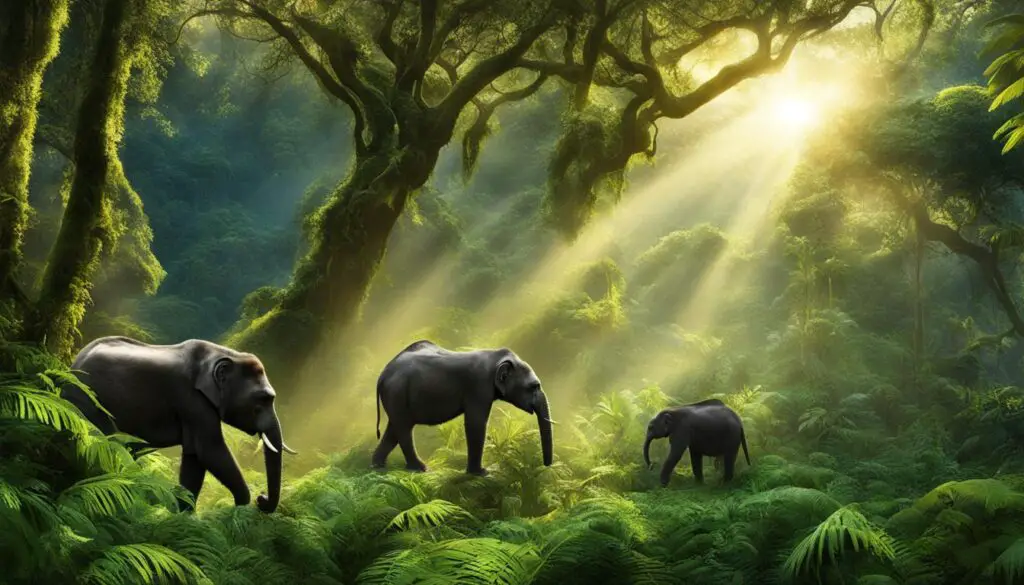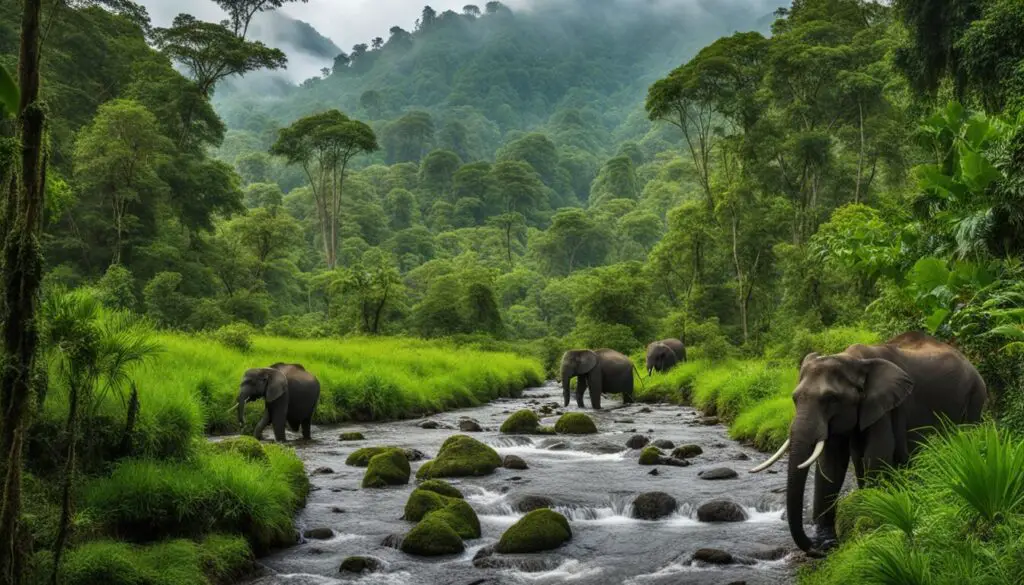Cameroon, located in Central Africa, is a country known for its incredible wildlife and rich biodiversity. This diverse nation is home to a vast array of animal species, making it a haven for wildlife enthusiasts and conservationists alike. From majestic mammals to colorful birds, Cameroon offers a truly captivating experience for those interested in the natural world.

Key Takeaways
- Cameroon is renowned for its diverse range of animal species, making it a hotspot for wildlife enthusiasts.
- The country boasts over 20 protected reserves, including national parks, zoos, and sanctuaries, to preserve its rich wildlife.
- Cameroon is home to various endangered species, including the Cross River gorilla, African elephant, and African golden cat.
- Efforts are being made to protect and conserve these vulnerable species through the establishment of specific reserves and sanctuaries.
- By visiting Cameroon’s protected areas and supporting conservation efforts, travelers can contribute to the long-term survival of the country’s native animals.
Habitats and Geography of Cameroon
Cameroon’s topography offers a diverse and captivating landscape, ranging from coastal areas to hill regions, with elevations reaching up to 2,000 meters. This varied geography contributes to the country’s rich biodiversity and provides different ecosystems for its wildlife. Let’s explore the habitats and geography of this remarkable African nation.
| Habitat | Location | Characteristics |
|---|---|---|
| Dense Rainforests | Southern Region | The southern region of Cameroon is characterized by dense rainforests, home to a wide range of plant and animal species. These lush forests are known for their towering trees, vibrant undergrowth, and impressive biodiversity. |
| Semi-deciduous Forests | Central Region | The central region of Cameroon is covered by semi-deciduous forests, which experience a moderate level of leaf shedding during the dry season. These forests provide a habitat for various wildlife species and support a diverse ecosystem. |
| Wooded Savannas | Northern Region | In the northern region of Cameroon, wooded savannas dominate the landscape. Here, vast grasslands and scattered trees create an open habitat favored by several species, including antelopes, monkeys, and migratory birds. |
The climatic conditions in Cameroon vary from lowland to highland, with equatorial to tropical climates. This diversity in climate further contributes to the country’s distinct habitats, supporting a wide array of plant and animal life. Notably, Mount Cameroon, standing tall at 4,070 meters, is the highest mountain in the country, offering breathtaking views and unique ecological zones.
Cameroon’s topography and habitats provide the foundation for its remarkable wildlife and contribute to its status as one of the most biodiverse countries in the world. The next section will delve into the various protected areas in Cameroon that play a crucial role in conserving this natural heritage.
Protected Areas in Cameroon
Cameroon is committed to conserving its natural heritage through the establishment of protected areas. These areas cover approximately 28,104 square kilometers and include national parks, forest reserves, and sanctuaries. They play a crucial role in safeguarding wildlife and their habitats, protecting them from threats such as habitat loss, poaching, and human activities.
Some of the well-known protected areas in Cameroon include:
- Dja Faunal Reserve
- Waza National Park
- Korup National Park
These areas are home to a diverse range of plant and animal species and offer visitors the opportunity to experience Cameroon’s unique biodiversity. By promoting eco-tourism, Cameroon’s conservation efforts not only contribute to the preservation of its natural resources but also provide sustainable economic benefits to local communities.

Exploration and Conservation in Dja Faunal Reserve
Dja Faunal Reserve, a UNESCO World Heritage site, is one of the largest protected wildlife areas in Africa. Covering an area of approximately 5,260 square kilometers, it is home to endangered species such as forest elephants, chimpanzees, and gorillas. The reserve offers guided tours, allowing visitors to explore the diverse ecosystems, including dense forests and riverine habitats.
Detailed Table:
| Protected Area | Location | Size |
|---|---|---|
| Dja Faunal Reserve | South-eastern Cameroon | 5,260 square kilometers |
| Waza National Park | Extreme North Region | 1,700 square kilometers |
| Korup National Park | South-western Cameroon | 1,260 square kilometers |
By supporting eco-tourism initiatives and visiting protected areas in Cameroon, travelers not only get a chance to witness the country’s incredible wildlife but also contribute to its conservation efforts. These protected areas are a testament to Cameroon’s commitment to preserving its natural treasures for future generations.
Endangered Species in Cameroon
Cameroon is home to several endangered species, including the Cross River gorilla, African elephant, and African golden cat. The Cross River gorilla, with less than 300 individuals remaining, is one of the most endangered great apes in the world.
Conservation efforts have been implemented to protect these species and their habitats, leading to the establishment of specific reserves and sanctuaries. Notable examples include the Kagwene Gorilla Sanctuary and Takamanda National Park. However, despite these protective measures, these species continue to face numerous threats, including habitat destruction, poaching, and population fragmentation.
Conservation initiatives in Cameroon focus on addressing these challenges and ensuring the survival of these vulnerable species. Through collaboration with local communities, government agencies, and international organizations, efforts are being made to conserve their habitats, enforce anti-poaching measures, and promote sustainable development.

Protecting these endangered species is of utmost importance not only for their survival but also for the preservation of Cameroon’s unique biodiversity. By raising awareness and supporting conservation efforts, we can contribute to securing the future of these remarkable creatures and the ecosystems they inhabit.
Conclusion
Cameroon, with its remarkable biodiversity and extensive network of protected areas, offers a haven for wildlife enthusiasts and conservationists. From the dense rainforests to the picturesque savannas, the country’s diverse habitats are home to a wide range of species, including majestic forest elephants and elusive rare birds. Despite the challenges of habitat loss and poaching, Cameroon remains committed to conservation and sustainable practices, ensuring the preservation of its unique natural heritage.
By visiting the protected areas in Cameroon and supporting local conservation efforts, travelers have the opportunity to contribute to the long-term survival of the country’s native animals and promote sustainable tourism. Whether exploring the pristine landscapes of Bénoué National Park or embarking on a wildlife safari in Waza National Park, every step taken towards responsible eco-tourism in Cameroon goes a long way in safeguarding the future of its magnificent wildlife.
Cameroon’s commitment to protecting endangered species, such as the Cross River gorilla and African elephant, is evident through the establishment of specific reserves and sanctuaries. These conservation initiatives aim to address the threats of habitat destruction, poaching, and population fragmentation, ensuring the survival of these vulnerable species. By supporting these efforts, we can help secure a future where Cameroon’s wildlife thrives and future generations can continue to marvel at the wonders of its natural heritage.
FAQ
How diverse is the wildlife in Cameroon?
Cameroon is home to a diverse range of flora and fauna, making it one of the most biodiverse countries in the world. It boasts over 20 protected reserves, including national parks, zoos, and sanctuaries, to preserve its rich wildlife.
What are the main habitats and geography of Cameroon?
Cameroon has three main habitats: dense rainforests in the southern region, semi-deciduous forests in the central region, and wooded savannas in the northern region. The country’s topography ranges from coastal areas to hill regions, with elevations reaching up to 2,000 meters. Mount Cameroon, standing at 4,070 meters, is the highest mountain in the country.
What are the protected areas in Cameroon?
Cameroon has approximately 28,104 square kilometers of protected areas, including national parks, forest reserves, and sanctuaries. Some well-known protected areas are Dja Faunal Reserve, Waza National Park, and Korup National Park. These areas aim to safeguard wildlife and their habitats from threats such as habitat loss, poaching, and human activities.
What endangered species can be found in Cameroon?
Cameroon is home to several endangered species, including the Cross River gorilla, African elephant, and African golden cat. These species are protected through the establishment of specific reserves and sanctuaries, such as the Kagwene Gorilla Sanctuary and Takamanda National Park. However, they still face threats from habitat destruction, poaching, and population fragmentation.
Why is Cameroon a prime destination for wildlife enthusiasts?
Cameroon’s rich biodiversity and abundance of protected areas make it a prime destination for wildlife enthusiasts and conservationists. The country’s varied habitats provide shelter to numerous species, from forest elephants to rare birds. By visiting Cameroon’s protected areas and supporting conservation efforts, travelers can contribute to the long-term survival of the country’s native animals and promote sustainable practices.
